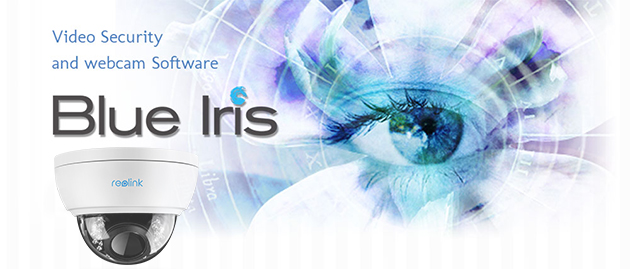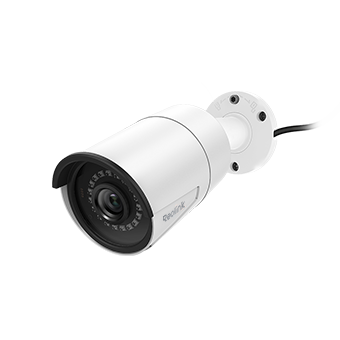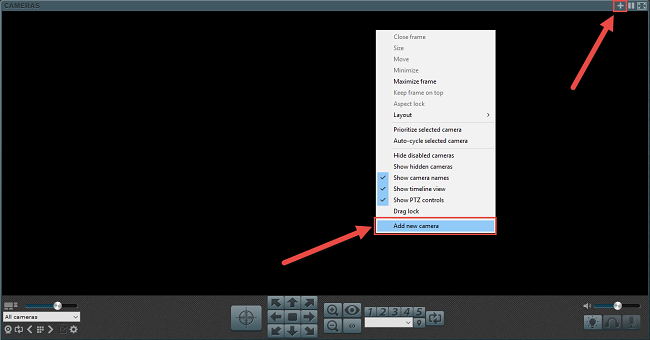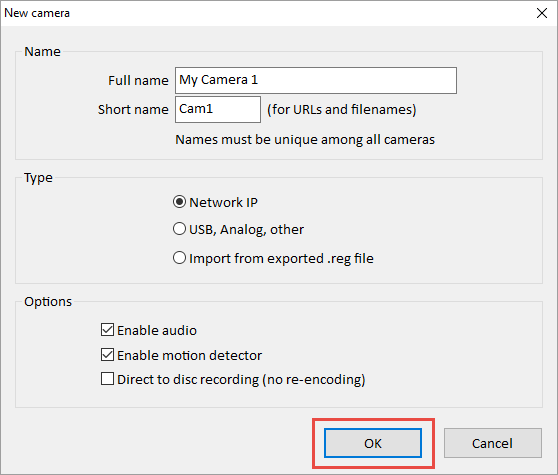Best Server Configuration for Blue Iris With Digital Cameras
With the appearance of Blue Iris, now you get another smart tool to access and control your security cameras. In this complete guide, you'll get deep insights on Blue Iris software, the recommended Blue Iris compatible cameras, step-by-step setup guides & hottest FAQs. If you have other questions about Blue Iris supported cameras, please leave them in the comment below.
Table of Contents:
#1. Blue Iris Cameras: Meaning & Top Features
#2. Blue Iris Compatible Camera Top Picks
#3. Set up Blue Iris IP Cameras: Step-by-Step Guide
#4. Troubleshooting for Blue Iris Security Cameras
When you want to buy Blue Iris security cameras, here is what you may need to know:
| Blue Iris Supported | Reolink/Amcrest/Hikvision |
| Features | Live streaming/motion detection |
| Recommended Camera | Reolink security cameras |
| Setup | Step-by-step guide/videos |
#1. Blue Iris Security Camera Knowledge Base: Meaning, Compatibility, Top Features & Costs
In order to help you get as many details as possible on Blue Iris webcam security cameras, we will break down this topic into 4 parts.
Every part will contain the points you want:
1. Meaning
2. Compatibility
3. Top Features
4. Costs
1. What Is a Blue Iris IP Camera
Blue Iris is a popular third-party software for you to access and control your security cameras via your computers, iPhones or Android smartphones.
You can use this professional CCTV camera software to keep tabs on your home, driveway, backyard, etc. watch your kids & pets, monitor your nanny, and enjoy video recording, playback and live streaming functions with your Blue Iris cameras.
As long as the security cameras support Blue Iris protocol, you can access the cameras with Blue Iris without any problems.
The advantages of Blue Iris mainly include:
- You can use different security cameras & systems from various brands on Blue Iris.
- Blue Iris is an open platform, and welcomes all companies and organizations.
Please note that not every security camera is completely compatible with Blue Iris, you need to check the compatibility details before your purchase.

2. Blue Iris Supported Camera List & Compatibility
In the market right now, most CCTV camera types are all compatible with Blue Iris, including 360° fisheye security cameras, WiFi, PoE or USB IP cameras.
Based on the test of Blue Iris' team, there are hundreds of tested security camera groups that are all compliant with Blue Iris.
You can check several popular Blue Iris supported camera brands:
- Reolink
- Amcrest
- Hikvision
- Dahua

Ready. Set. Save!
Big selection, big SAVING. Get your hands on Reolink security cameras & systems before the best prices slip away!
You can check the full Blue Iris compatible camera list here.
But wait. Blue Iris engineers did have tested the IP cameras to see whether they are compliant with their software.
BUT they might not test if every function of a camera can be used in Blue Iris.
So you are gonna need to check the Blue Iris camera compatibility features below.
3. Blue Iris IP Camera Compatibility: What Features You'll Get
Due to the limitations of Blue Iris software and specific security camera manufacturers, you may not use every function of your cameras on Blue Iris in some cases.
So you'll need to check the detailed Blue Iris camera compatibility of the security camera brand.
Take Reolink Blue Iris compatible cameras (except the battery security cameras) as a typical example.
Reolink team has done severe tests on the compatibility between their cameras and Blue Iris.
The result is that Reolink security cameras can "talk" to Blue Iris in almost every way. In other words, you can use almost every function of the cameras on Blue Iris software.
Top features of Reolink security cameras you can get with Blue Iris recording software
- Live streaming
- Motion detection
- Video recording
- Audio recording (for security cameras with audio)
- PT control (only for pan tilt security cameras)
- Zoom in/out
- Auto focus
- Preset (for Blue Iris PTZ cycle cameras)
- Email alerts
Yep, you can get almost all of the advanced features of Reolink cameras (except the battery security cameras) when using Blue Iris IP camera viewer.
But don't forget the costs.
4. Blue Iris License & Tech Support Fees: How Much You Need to Pay
You'll need to pay for license and tech support when using Blue Iris professional IP camera recording software.
Before purchasing the Blue Iris license, you'll get free 15-day trial, after that you'll need to pay for the license.
You can get life-time Blue Iris license after your payment. Blue Iris license cost details are as below:
• The LE version only supports a single camera at a price of $29.95.
• The full version supports multiple Blue Iris security cameras (up to 64 cameras), at a price of $59.95.
If you need to install multiple security cameras, or wanna expand more cameras in the future, the full version would be a much more cost-saving option in a long run.
Also you'll need to pay for the tech support of Blue Iris. You'll get 1-year basis support plan for free. When your basic support plan expires, you'll need to upgrade the plan into the Extended or Priority plan with $29.95 & $59.95 annually.
Blue Iris Support Plan Details & Prices
| Support Plans & Features | Basic | Extended | Priority |
| Current Version Updates | Yes | Yes | Yes |
| Major Version Upgrade Protection | 30 Days | Yes | Yes |
| Email Support | Yes | Yes | Yes |
| Prioritized Email Support | — | Yes | Yes |
| Highest Priority Email Support | — | — | Yes |
| Phone Support (Limited & By Appointment) | — | — | Yes |
| Remote Desktop Support (Limited & By Appointment) | — | — | Yes |
| Price | Free | $29.95 | $59.95 |
| Duration | 1 Year | 1 Year | 1 Year |
Note : The information in the chart above is quoted from Blue Iris official website.
Considering the costs of using Blue Iris network camera software, the customized software of the security camera manufacturer would be a better choice.
You can use the software without any charges and get free tech support. You don't need to worry about the compatibility at all.
And running Blue Iris on your computer may lead to CPU problem (we'll illustrate this issue in Part 4).
That's also one of the most important reasons why you need to use the customized client and app instead of the Blue Iris IP security camera software.
So you can pick video cameras that are both compatible with Blue Iris app/client and the customized software.
#2. Blue Iris Compatible Security Camera Recommendations
We pick 2 Blue Iris recommended cameras, including PoE & wireless types, for your reference.
Both of the 2 security cameras got high praise from professional tech reviewers and customers.
Pick 1. RLC-410 Blue Iris PoE Security Camera
As one of the most popular and best Blue Iris cameras, RLC-410 can work seamlessly with Blue Iris software.

Reolink RLC-410
PoE Bullet IP Security Camera with Audio
5MP/4MP Super HD; Outdoor/Indoor Protection; 100ft Infrared Night Vision; Audio Recording; Mobile Remote Access & Control.
Based on a tech reviewer of The Doc's World, the editor said:
Blue Iris instantly picked up the camera once I gave the IP address/port (I use custom ports on all cameras) and within a few minutes I was recording at full resolution.
If you are looking for a versatile Blue Iris home IP security camera, you can try this one. With only about $50, you can buy a 5MP Super HD camera for all-around property security.
You can check the below video to see the clarity of this Blue Iris recorder camera.
Video Transcription
In the video, you can see a crystal scenery captured by this Blue Iris HD camera that a ship is cruising on the sea.
You can even see the far-away water wave through this Blue Iris outdoor & indoor camera thanks to its high resolution.
If you want the best rotate moving security camera to pair with Blue Iris for retail security or wide-range property, you can try out a PoE PTZ security camera.
Pick 2. Reolink E1 Pro Wireless Indoor Pan Tilt Security Camera
If you are looking for Blue Iris compatible baby monitor, you can start from Reolink E1 Pro camera.

Reolink E1 Pro
Wireless Pan-Tilt Smart Home Camera
Smart, Powerful and Affordable All-Round Home Protection. 355° Pan and 50° Tilt; 4MP Super HD, Two-Way Audio, 2.4/5 GHz WiFi, with Google Assistant Integration.
This wireless indoor security camera is fully compatible with Blue Iris. You can use Blue Iris to use the pan-tilt function of this camera.
You can watch the below video captured by this Blue Iris portable home security camera.
Video Transcription
A 5.3-magnitude earthquake that took place in Athens, Greece on July 19th. This Blue Iris remote P2P camera captures the shaking on the 4th floor of a building.
Note: The above security cameras are only compatible with Blue Iris and Reolink NVRs for continuous recording. They cannot work with other NVR/DVR brands.
Adding a new security camera to Blue Iris is not as simple as the customized software.
You can follow the step-by-step guide to add your IP cameras to Blue Iris software.
#3. Blue Iris IP Camera Setup: Step-by-Step Guide & Videos
With this detailed guide, you can make your Blue Iris network IP camera configuration or installation like a breeze.
Here we'll take Reolink Blue Iris compatible cameras (except the battery security cameras) as an example to show you the step-by-step guide on adding cameras to Blue Iris.
Step 1. Set H.264 profile as Baseline of your camera on Reolink Client.
1) Download and launch Reolink Client on your computer or Mac.
2) Click Add Device, and then change Register Mode into UID. Fill in the required fields, including Device Name, UID, User Name (the default user name is admin) & Password.
(You can also click Scan Device in LAN to add the camera to Reolink Client if your computer and camera are in the same network.)
Click OK to finish adding the camera on Reolink Client.
3) Click Device Settings -> Recording Encode. Set the H.264 Profile as Baseline. (Check the Record Audio box if your security camera supports audio recording).

You can also view the below tutorial video to set H.264 profile as Baseline on Reolink Client.
Step 2. Add Reolink cameras to Blue Iris.
1) Download and launch Blue Iris on your PC or Mac.
2) Click "+" button at the top right of the Blue Iris software, or right click and select Add new camera to add Reolink camera to Blue Iris.

3) Input the camera name and choose Network IP as the connection type. Check Enable audio and Enable motion detector in the Options menu. Click OK to continue.

4) Please enter the correct User Name and Password. Click Find/inspect… button to search the camera in LAN.
In the current inferface, you are gonna need to do several setup steps:
- Select the Make as Reolink.
- Change the Discovery/.. ort into 8000.
- Click OK to finish adding the camera to Blue Iris.
Here is a video to show you how to add Reolink cameras (except the battery security cameras) to Blue Iris from the beginning to the end.
If you use Reolink PTZ security cameras, such as RLC-423, please enable PTZ function on Blue Iris by clicking the PTZ/Control tab and checking Enable Pan/Tilt/Zoom and other controls (focus. Brightness, etc.).
Don't forget to set Network IP.
You can follow this step-by-step guide to call PTZ IP camera preset on Blue Iris.
If you have any questions about adding Blue Iris security (DVR) cameras, please leave your questions in the comment below.
We will feature your question in the FAQ part. Please share you points with us here!
#4. Blue Iris IP Cameras Troubleshooting & Hottest FAQs
We came across many questions about using Blue Iris to access cameras on forums, so we decide to make a specific part here to help you address the questions you may have on Blue Iris CCCTV cameras.
Q 1. How to Solve Blue Iris CPU Usage Problem
A 1: When you use Blue Iris to control your surveillance cameras, BI's motion detection and transcoding would consume much CPU power of your computer.
You can try the below 5 useful tips to minimize the CPU consumption caused by Blue Iris.
Tip 1. Turn on direct-to-disc recording. It records the cam streaming without re-encoding. However, it has downsides. Blue Iris won't be able to add its own overlays (time and camera name).
Tip 2. Turn the video frame rate down to 15-20 fps.
Tip 3. Reduce pre-event capture to 40 frames.
Tip 4. Turn down the sensitivity level of the motion-triggered setting.
Tip 5. Shorten the pre-recorded time in motion detection setting.
Q 2. How Many Cameras Does Blue Iris Support
A 2. As mentioned above, Blue Iris can support multiple (maximum 64) cameras with the full version license.
And Blue Iris LE version license only supports 1 camera.
Q 3. Blue Iris Camera No Signal
Dahua, Amcrest, Foscam cameras etc. Blue Iris no signal!
Signal loss every minute for a few seconds using Blue Iris.
A 3. If you encounter security camera signal loss when using Blue Iris, you may try the below solutions to troubleshoot the issue.
Solution 1. Update Blue Iris to the latest version.
Solution 2. Lower the camera's frame rate.
Solution 3. Reboot your security cameras & Blue Iris software.
Q 4. How to Rearrange Cameras on Blue Iris
How to change the security camera group order on Blue Iris?
A 4. If you cannot change your security camera layout on Blue Iris, you may follow the below 2 simple steps to fix it.
Step 1. Right click the blank space in the Blue Iris window.
Step 2. Uncheck drag lock.
Now you can change the security camera group layout on Blue Iris.
Q 5. Blue Iris Cameras Recording Issues
Trigger recording not working! Blue Iris not recording new clips.
Blue Iris won't record new cam. Blue Iris motion detection suddenly not working at night.
A 5. You can try the below troubleshooting tips below to fix Blue Iris recording issues.
– Issue 1. Blue Iris won't record videos, both motion-triggered and continuous videos.
Troubleshooting 1. Upgrade your Blue Iris to the latest version.
Troubleshooting 2. Make sure you've enabled the motion detection or 24/7 recordings on Blue Iris.
Troubleshooting 3. Turn on direct-to-disc recording.
– Issue 2. Blue Iris not creating new recording for hours? What settings do I need to fix?
If you expect each of motion-triggered video recordings is stored separately, please follow the below simple steps:
On the camera properties, please click Record tab, and then uncheck Combine or cut video each.
– Issue 3.How to Record 24/7 with Blue Iris
With the below several easy steps, you can get your security camera record 24/7 on Blue Iris.
Step 1. Right click the camera.
Step 2. On the camera properties, click Record tab.
Step 3. Select Continuous under Video.
Q 6. How to Set up Motion Detection and Video Recording on Blue Iris
A 6. After you've added your camera to Blue Iris, you can follow the below instructions to set up motion detection with Blue Iris.
Step 1. Click the camera icon  at the top/left of the Blue Iris window, and then click the Motion/Trigger tab.
at the top/left of the Blue Iris window, and then click the Motion/Trigger tab.
Step 2. Check the required boxes, including Enable under Motion sensor, Object detection, Use zones and hot spot, High definition, Cancel shadows and Trigger using cameras' digital input or motion, and then click OK.

Step 3. Click the Record tab, and then check the required boxes including Video, JPEG snapshot each & Create Alert list images when triggered, and then click OK.
Now you can get motion detection recordings with the Blue Iris.
Q 7. Blue Iris Requirements and Setup Questions
Is my system powerful enough to do motion recording for 4 cameras using Blue Iris?
What video settings is recommended (FPS, resolution, etc.)?
A 7. According to Blue Iris' team, the minimum requirements for your computer is:
- A dual-core or equivalent 2 GHz processor or better
- More than 2 GB RAM
- At least Microsoft XP SP3 or newer version, such as Window 7 & 10, or a server OS
- 1 or more camera with DirectShow drivers
If you use multiple Blue Iris security cameras, such as 12, 16, 30 or even maximum 64 cameras, you need a much more robust computer. Recommendations include:
- Intel core i7 with QuickSync for hardware decoding
- More than 8 GB RAM
- Microsoft Windows 8.1 or 10, 64 bit
- nVIDIA graphics adapter for efficient screen display
- 7200+ RPM drives and/or SSD drive
In order to minimize your computer CPU consumption, you may set up the video frame rate into 15-20 fps.
Q 8. Security Camera Systems: Differences Between NVR and Blue Iris + PC, Which One Is Better
Dedicated NVR vs. PC w/ Blue Iris, which one to choose?
NVR or Blue Iris for 8 1080p IP cameras?
A 8. If you only need 2 or 3 IP cameras to run 24/7, and/or happen to have an idle computer, you can opt to Blue Iris + PC option.
Your computer storage space can handle several IP cameras recording continuously.
But if you want 4 or more cameras, a dedicated NVR would be the way to go.
Typically, the cameras and NVRs from the same brands can work seamlessly. All the videos will be stored in the hard disk of the NVR for your later playback.
If the storage space of the NVR is running out, it would automatically overwrite the oldest video footage, so you don't need to delete the videos manually.
You can check more details on NVR vs PC for security camera video storage here >>
If you have any problems about Blue Iris IP cameras, you can leave your questions in the comment below!
gagnethermagreast.blogspot.com
Source: https://reolink.com/blue-iris-ip-security-cameras/
0 Response to "Best Server Configuration for Blue Iris With Digital Cameras"
Post a Comment